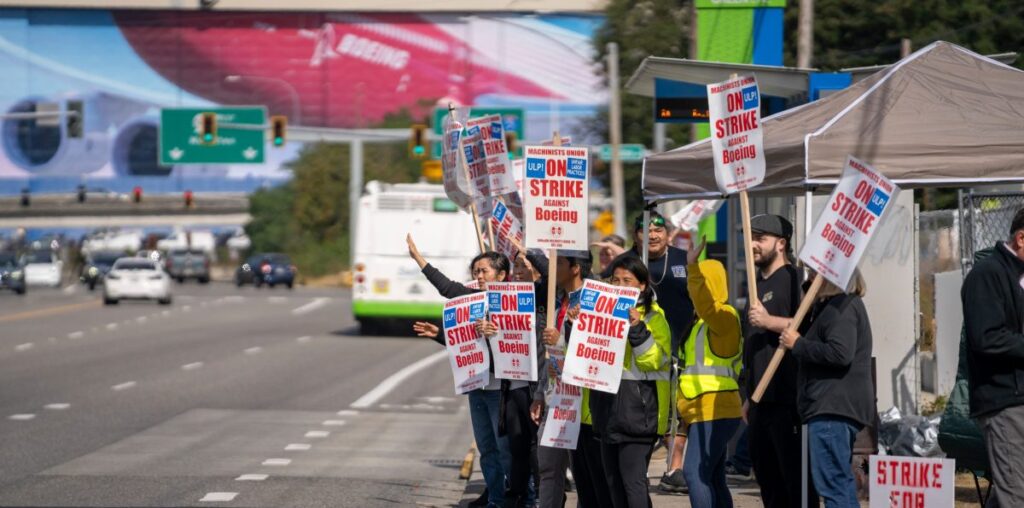
Kelly Ortberg’s earnings debut as Boeing Co. chief executive officer has gained an element of suspense as workers vote on the same day whether to accept the planemaker’s latest proposal and end a five-week-long strike.
Boeing and the union representing 33,000 striking members hammered out a tentative new accord that notches up pay by 35% over four years, an unprecedented wage increase.
But the hourly workers have the final say with their Oct. 23 vote, and approval is far from certain. They overwhelmingly rejected a deal in September that had labor leaders’ blessing. This time, union negotiators aren’t endorsing the proposal.
The outcome of the vote, which needs a simple majority to pass, won’t be known until late in the day in Seattle, Boeing’s main manufacturing hub. That means investors, employees and executives will be left hanging for hours after the earnings, uncertain as to whether Boeing can finally start on the path to recovery — or be forced to keep muddling through with anemic production and dwindling cash reserves.
The strike has become a defining episode for Ortberg, who inherited a set of interlocking crises when he took over in early August. He’s already announced a 10% workforce reduction that will sweep across all ranks of the planemaker, and he put together the first contours of a $25 billion refinancing package that aims to steady the company in the next three years.
“If there’s this perception that his first couple of months have been somewhat unblemished by success, this would be a terrific step in turning that around,” Richard Aboulafia, an aerospace analyst at Aerodynamic Advisory LLC, said of the contract vote. “It would de-risk an incredibly dangerous situation.”
The manufacturer faces the threat of its credit rating being cut to junk if the work stoppage drags on, a move that would increase borrowing costs and impede its access to capital. The squeeze extends to Boeing’s fragile supply chain, where any staffing cuts could hurt efforts to speed up factories again after the strife ends.
Ortberg’s efforts to reset Boeing’s culture and relations with employees have been hurt by the strike. The announcement of job cuts, alongside a wide range of other measures, threatens to drive a wedge into the already fragile rapport between senior management and the shop floor.
Boeing’s crisis of confidence extends not only to investors who have pushed down the stock by 41% this year. The company has been subject to whistleblower accounts recounting years of unauthorized work and defects that allege management prioritized production targets and financial goals over diligence and sound workmanship.
Cascading Crises
The new CEO, who joined out of retirement after cascading crises since the start of the year led to the departure of his predecessor, has sought to appeal to a sense of solidarity and common destiny. He’s also made a point of being closer to the action, buying a house in the Seattle area and spending more time on the factory shop floor.
Ortberg has made clear he’s contemplating structural changes, telling employees that resources are spread too thin. The manufacturer could net as much as $20 billion selling an array of assets that aren’t essential to its main commercial and defense businesses, like its Jeppesen navigation subsidiary, analyst Cai von Rumohr of TD Cowen wrote in an Oct. 1 report.
The strike has exposed fault lines inside a company where senior executives long focused on returns, while Machinists saw their wages eaten up by inflation and their pension plan evaporate under a controversial 2014 contract. Many employees have therefore vowed hold out for a significantly better deal.
That’s why it’s not certain the latest overture, reached with the help of an encouraging nudge from the White House, will succeed. Leaders of the International Association of Machinists and Aerospace Workers District 751 didn’t provide a recommendation how members should vote on the tentative agreement, which doesn’t restore pensions.
Boeing will unveil earnings before markets open in the US on Oct. 23. The company already disclosed some key metrics when it announced the planned job cuts on Oct. 11, including quarterly revenue that missed analyst estimates and $5 billion in charges related to different programs.
Taking Time
Boeing also said it had a cash outflow of $1.3 billion in the period, adding to the more than 7$ billion-drain in the preceding two quarters.
With the main results already out, Ortberg will have more leeway to address his plans for Boeing. The turnaround effort will be easier once the main commercial factories restart around Seattle, ending a walkout that has cost it about $100 million a day in lost revenue, by some estimates.
Still, rebooting the assembly lines will be a gradual process, given the complexity of coordinating hundreds of thousands of parts while hiccups still ripple across the aerospace and defense supply chain.
Douglas Harned, an analyst at Bernstein, said that even a strike resolution in late October would mean that deliveries of newly produced aircraft will essentially remain shut down going into November. If strikes in the past are any measure, a recovery will take time, he said.
“Boeing is not going away,” Harned wrote in an Oct. 17 report. “But, it is not clear today what the company will look like in five years.”

